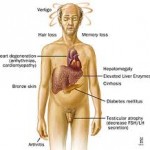 Hemochromatosis is not a well known name. It is often referred to as having “too much iron in the blood.” An unfortunate reality is it’s a quite common affliction. Usually the digestive system assimilates only sufficient iron to restore ordinary losses. Individuals who have a pair of hemochromatosis genes absorb excessive iron. The surplus is stored in several internal organs, such as the liver, pancreas, cardiovascular system, pituitary and testicles, and gravely injures them.
Hemochromatosis is not a well known name. It is often referred to as having “too much iron in the blood.” An unfortunate reality is it’s a quite common affliction. Usually the digestive system assimilates only sufficient iron to restore ordinary losses. Individuals who have a pair of hemochromatosis genes absorb excessive iron. The surplus is stored in several internal organs, such as the liver, pancreas, cardiovascular system, pituitary and testicles, and gravely injures them.
Symptoms that those body organs are in danger will not show up till middle age. Often the initial sign of problems is irregular liver assessments, found if an individual takes a test for an unrelated cause. When hemochromatosis is identified early on, therapy can start quickly and internal organs are preserved. When it continues to go hidden, liver cirrhosis, liver cancer, and diabetic issues are possible results.
With early treatments, hemochromatosis sufferers can live an ordinary lifestyle. Treatment methods are uncomplicated. They include regular elimination of blood, the human body’s storage site for iron. Since this is an inherited condition, ones close family members – mother and father, siblings – ought to be tested for this.
A hereditary check for your partner will show you if your kids should also get a hereditary examination. The gene evaluation is a relatively recent development for hemochromatosis. It enables quick therapy and helps prevent the additional complications of the disease.
The therapy is straightforward and successful. When the situation is discovered early before any kind of body organ injury happens, the individual should have a typical life span. The sooner the iron overload is discovered, the less possibility of problems happening. If injury has already started to take place, then treatment can stop additional harm. A person’s prospects are dependent on how severe the damage is.
The procedure for reducing stored iron can be referred to as Phlebotomy or Venesection, and it is exactly the same process as you get when providing a blood donation. This really is regarded as the best and most efficient way of decreasing saved iron. The objective of the therapy is to lessen saved iron within body tissue towards the lower end of the normal range, while averting anemia.
At first, the procedure will be done once or twice a week in order to quickly lower iron levels Then, when regular ranges are attained, maintenance may possibly require several sessions annually for the rest of that person’s life. The earlier the iron concentrations are normalised, the better the prospects are for the affected person.


JoAnn
My percent of iron saturation is 48% and my doctor wants me to eat more vegetables to try to correct this. Should I be worried and do something else? He wants to re-test in January.